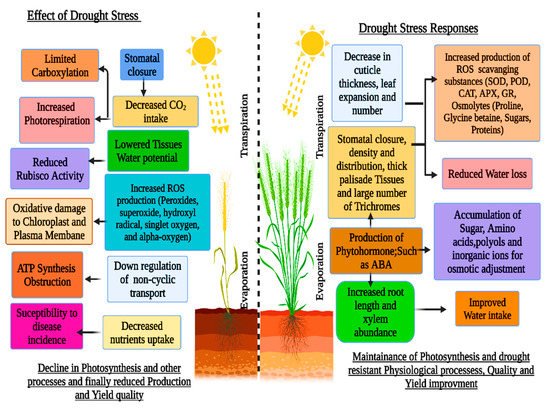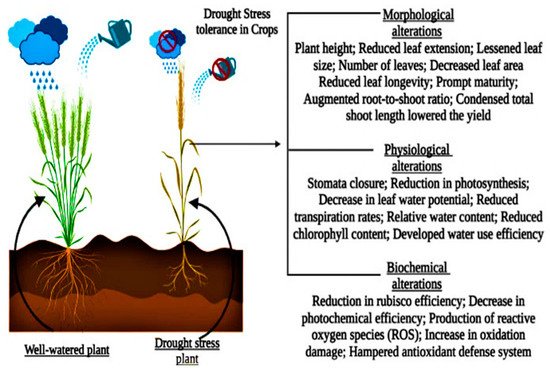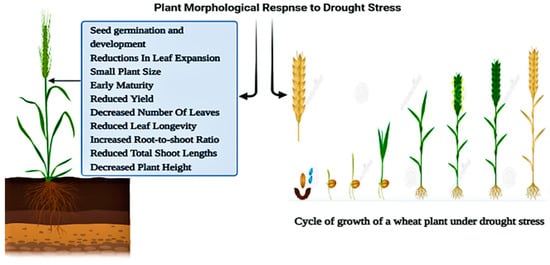You're using an outdated browser. Please upgrade to a modern browser for the best experience.
Please note this is a comparison between Version 1 by Baber Ali and Version 4 by Abdul Wahab.
Drought stress is the most challenging issue to agricultural productivity and has a pronounced negative effect on plant growth, development, and productivity. Drought stress adversely affects morphological aspects of plants, such as early germination, plant height, relative root length, root diameter, the total biomass of leaves and roots, number of leaves/plants, and branch number/plant.
- drought stress
- abiotic stress
- plant morphology
1. Drought Stress
Changing climatic regimes are posing a threat to life on Earth because meeting the rising food demand and achieving sustainable agriculture for a growing population is becoming an uphill task in the present scenario of changing climatic conditions [1], which include droughts, heavy floods, earthquakes, and temperature variations [2][3][2,3]. Drought stress interrupts many physio-biochemical processes, hindering plant growth and development [4][5][4,5]. Plants can frequently withstand limited water conditions but at the cost of substantial loss in total biomass and productivity. Drought affects around half of the world’s semi-arid and arid areas. Photosynthesis, growth, and other critical physiological and biochemical activities are interrupted under drought stress conditions [6][7][6,7]. Previous studies [8][9][10][8,9,10] found that drought stress causes oxidative stress, damaging biological membranes and macromolecules (DNA, proteins, lipids, and photosynthetic pigments). Plants engage their natural defense systems in response to oxidative stress and create osmolytes [11], such as soluble proteins, proline, soluble sugars, and glycine betaine [12].
Osmolytes, also known as osmoprotectants, are found mainly in the cytoplasm and prevent cellular deterioration by maintaining the cell’s osmoregulation. Because osmolytes are non-toxic and highly soluble, they do not interfere with other physiological and biochemical processes [13][14][13,14]. Plants generate antioxidant substances such as flavonoids, carotenoids, vitamins, and antioxidative enzymes such as glutathione reductase (GTX), superoxide dismutase (SOD), catalase (CAT), peroxidase (POD), and ascorbate peroxidase (APX) in response to abiotic stress [15][16][15,16]. Water deprivation causes reduced turgor pressure and oxidative damage from reactive oxygen species (ROS), including superoxide and hydroxyl radicals, nitric oxide and singlet oxygen, causing alterations in leaf gas exchange rates [17] (Figure 1). Natural drought-resistance mechanisms in plants have been well developed, including morphological, physiological, and biochemical adaptations, such as drought-resistant epigenetic plasticity and gene activation [18]. Drought resistance and transformation in food legumes and crop plants are maintained through morphological, physiological, and biochemical changes. These characteristics may assist crops in adapting to harsh environmental conditions. Imbalances in nutrition are caused by drought stress, causing significant ecological constraints on agricultural output worldwide [19].

Figure 1. Effects of drought stress on sensitive and tolerant wheat (Triticum aestivum L.) crops.
Drought stress is the most challenging issue to agricultural productivity and has a pronounced negative effect on plant growth, development, and productivity. Making it difficult to maintain a sustainable agricultural system worldwide [19][20][19,20]. Drought-induced changes in wheat characteristics were investigated, and their impact on agronomic attributes and yield were studied. Spikelet fertility and grain filling were affected negatively by drought stress [21]. Maize (Zea mays L.) and wheat (Triticum aestivum L.) crops water limitations lead to reduced crop yields and quality]. Water stressed conditions reduce agricultural output and put food production at risk [22][23][22,23]. Reduction in agricultural productivity leads to shrinking revenue for local farmers. The loss of production substantially impacts farmers’ livelihoods and economies [24]. Wheat (Triticum aestivum L.) crop is a major cereal crop and a common food source worldwide. Wheat (Triticum aestivum L.) crop with improved drought tolerance is essential for long-term food production and global food security [25]. Many critical genes and transcription regulators controlling morpho-physiological and biochemical features have been discovered due to recent developments in drought tolerance research [26] (Figure 2).

Figure 2. Drought stress impacts plants’ morphological, physiological, and biochemical processes.
2. Drought-Induced Changes in Plant Morphology
Drought stress adversely affects morphological aspects of plants, such as early germination, plant height, relative root length, root diameter, the total biomass of leaves and roots, number of leaves/plants, and branch number/plant [27][28][27,28].
2.1. Early Seed Germination and Flowering
Water is essential for seed germination; however, while other conditions may be ideal, drought stress inhibits the imbibition of seeds and, consequently, hinders germination [29]. Similarly, it reduces seedling vigour and impacts germination by lowering water intake [30]. In the early stages of crop development, drought stress manifests through reduced seed germination resulting in poor stand establishment [31]. Poor seedling germination was observed under exposure to drought stress in two crops: rice (Oryza sativa L.) and pea (Pisum sativum L.) [30][32][30,32]. Low water content in the soil combined with other environmental factors can alter germination success. Drought stress considerably influences Zea mays L. seedling germination [33][34][33,34]. Some field crops are particularly vulnerable to cold and dryness, especially during germination and seedling development (early phases). Every seed has optimal soil moisture levels and temperature for germination [35].
2.2. Plant Morphological Characteristics of Leaves under Drought Stress
Drought stress substantially influences the internal plant components that increase plant height [35]. Plant height loss might be related to decreased cell growth, a high rate of leaf abscission under dryness, and poor mitosis [36][37][36,37]. Water stressed conditions considerably reduced the number of leaves in Zea mays L. [34][38][34,38]. The study by [33] showed that sweet basil (Ocimum basilicum) leaves are significantly more critical than shoot and roots because leaves are responsible for photosynthesis and contain photosynthetic pigments. Drought regimes reduce leaf area and plant total biomass [39]; by limiting leaf growth and affecting the photosynthetic process. Previous research studies reported that leaf area was significantly decreased under drought stress conditions in many crops, including Triticum aestivum L. and Oryza sativa L. [39][40][39,40]. Loss of water from the upper epidermis of the leaf results in diminishing leaf pressure potential, which causes the leaf to roll. Reduced leaf temperature, increased interception of the incident light, and increased transpiration rate benefit this phenomenon. Under drought stress regimes, leaf area and leaf rolling were dramatically enhanced in maize (Zea mays L.) crop leaves [41].
2.3. Plants Shoot Morphology and Architecture under Drought Stress
Drought stress has a negative impact on shoot length and fresh weight. In Phaseolus vulgaris L., however, there was a considerable drop in the dry weight of the shoot [42]. Conversely, the shoot length in maize (Zea mays L.) crop was discovered, which needs to recover by supplying adequate water and nutrients for survival and defeating drought stress conditions [43]. Similarly, it was observed that the seedling length of maize (Zea mays L.) was dramatically reduced under drought stress. The water shortage tremendously affects maize crops’ dry weight after drying in shades [44]. The results showed drought stress considerably affects maize (Zea mays L.) crops’ fresh weight compared to control. In such situations, the plant needs a well-developed root system attaching themselves and collecting water and nutrients from their environment [45].
2.4. Plant Root Morphology and Architecture under Drought Stress
Drought stress alters agricultural plants’ root architecture and morphology. During abiotic stress conditions, many plants’ root biomass increases as the roots’ length become more prolonged, and more water and minerals are absorbed from the soil [18][46][18,46]. Furthermore, polyethylene glycol-induced drought stress decreased hypocotyl length and fresh and dry weight roots in maize (Zea mays L.) while increasing root length [47]. Sometimes, moderate drought has no pronounced negative impacts on root development [48]. Root development in maize, for example, was unaffected by water stress [49]. Previous research found that drought stress boosted root development in two plants, Catharanthus roseus L. and Helianthus anuus L. [49]. Drought stress affects crops, but the most relevant characteristic is increased legumes, shoot, and root-shoot ratios in different plant species [16]. Root architecture plays a crucial role in plant growth and development. When plants are subjected to water-stressed conditions, their roots elongate into the ground, reaching deeper and absorbing enough water and minerals to survive [43].
2.5. Yield
In some plant species, yields may be reduced depending on the period and intensity of the limited water condition; nevertheless, the lack after anthesis is deleterious to crop yields regardless of the severity and time of the deficit. Drought stress lowers yields in several ways [50]. In barley (Hordeum vulgare L.) and wheat (Triticum aestivum L.) crops, drought stress reduced the number of spikes, tillers, and grains per plant, as well as the grain weight [51][52][51,52]. Reduced millet (Pennisetum glaucum L.) production by drought stress caused silking to be delayed and the anthesis-to-silking gap to be lengthened [53]. Drought stress harmed soybean seed production and influenced the physiology and yield of crop germplasms [50]. This trait was substantially related to grain production, namely the number of ears and kernels per plant [54]. The association was investigated between grain yield, grasslands, and harvest index [55].
DHere we are discussing that drought stress dramatically impacts plants’ morphological characteristics of wheat corps (Triticum aestivum L.). Drought stress significantly affects the early stages of seed germinations [56]. In leaf morphology, drought stress also plays a critical role, such as; a reduction in leaf expansions and leaf rolling [57]. Productions of Yield quality and yield losses in wheat crop (Triticum aestivum L.) species have been linked to a limited water conditions, with the severity and duration being the focus factors in this association, as shown in Figure 3 [58].

Figure 3.
Impact of drought stress on morphological aspects: Cycle of growth of a
Triticum aestivum
L. plant.
